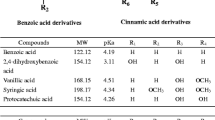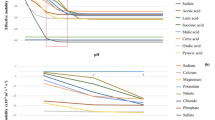Abstract
Transient isotachophoresis (tITP) is a universal online sample preconcentration technology. It uses ITP to focus electrically charged analytes during the initial stage of capillary electrophoresis (CE) analysis, which can effectively improve the sensitivity of CE. In this work, an approach of tITP under counter-electroosmotic flow was developed for capillary zone electrophoresis (CZE) determination of five trace food additives which include benzoic acid, sorbic acid, sunset yellow, allura red, and amaranth in beverage samples. The parameters that affect the preconcentration effect of the system, such as the type of terminating electrolyte and its injection time, the preconcentration time of ITP, and the sample injection time, have been investigated in detail. The mechanism of counterflow-tITP was explored preliminarily. Under optimal conditions, the sensitivity of five food additives was improved 11.9, 11.5, 13.04, 10.05, and 15.3 times. Their limits of detection (LODs, S/N = 3) reached 0.15, 0.10, 0.38, 0.33, and 0.11 μg/ml, with good repeatability (peak area RSDs ≤ 6.9%) and calibration graph linearity (r ≥ 0.9992). Recoveries of five food additives in spiked beverage samples ranged from 92.0 to 100.8% with RSDs between 1.38 and 2.95%. This method is simple, rapid, and sensitive. It has been successfully applied to the separation and detection of trace food additives in cocktails, orange juice, and carbonated beverages. The feasibility of determination of trace additives in beverages by tITP-CZE under the condition of counterflow has been confirmed.





Similar content being viewed by others
References
Abdol-Samad A, Abdorreza M, Ebrahim A, Mohammad MA, Ramin K (2014) Simultaneous determination of sorbic and benzoic acids in milk products using an optimised microextraction technique followed by gas chromatography. Food Addit Contam A 31:21–28. https://doi.org/10.1080/19440049.2013.859742
Aemi SAK, Rosanne MG, Christopher JSB, Michael CB (2014) Transient isotachophoresis- capillary zone electrophoresis with contactless conductivity and ultraviolet detection for the analysis of paralytic shellfish toxins in mussel samples. J Chromatogr A 1364:295–302. https://doi.org/10.1016/j.chroma.2014.08.074
Bailon-Perez MI, Garcia-Campana AM, Cruces-Blanco C, Del Olmo IM (2007) Large- volume sample stacking for the analysis of seven beta-lactam antibiotics in milk samples of different origins by CZE. Electrophoresis 28:4082–4090. https://doi.org/10.1002/elps.200700305
Chu C, Lian LM, Liu CJ, Li J, Mao H, Jiang LY, Yan JZ (2020) Online preconcentration by electrokinetic supercharging for sensitive determination of berberine and jatrorrhizine in biological samples. Biomed Chromatogr 34:e4824. https://doi.org/10.1002/bmc.4824
Doguc DK, Ceyhan BM, Ozturk M, Gultekin F (2013) Effects of maternally exposed colouring food additives on cognitive performance in rats. Toxicol Ind Health 29:616–623. https://doi.org/10.1177/0748233712436638
Doguc DK, Deniz F, İlhan İ, Ergonul E, Gultekin F (2019) Prenatal exposure to artificial food colorings alters NMDA receptor subunit concentrations in rat hippocampus. Nutr Neurosci. https://doi.org/10.1080/1028415X.2019.1681065
Hattori T, Okamura H, Asaoka S, Fukushi K (2017) Capillary zone electrophoresis determination of aniline and pyridinein sewage samples using transient isotachophoresis with a system-induced terminator. J Chromatogr A 1511:132–137. https://doi.org/10.1016/j.chroma.2017.07.009
Hsu SH, Hu CC, Chiu TC (2014) Online dynamic pH junction-sweeping for the determination of benzoic and sorbic acids in food products by capillary electrophoresis. Anal Bioanal Chem 406:635–641. https://doi.org/10.1007/s00216-013-7481-1
Huang HY, Shih YC, Chen YC (2002) Determining eight colorants in milk beverages by capillary electrophoresis. J Chromatogr A 959:317–325. https://doi.org/10.1016/S0021-9673(02)00441-7
Jiang LL, Li K, Yan DL, Yang MF, Ma L, Xie LZ (2020) Toxicity assessment of 4 azo dyes in zebrafish embryos. Int J Toxicol 39:115–123. https://doi.org/10.1177/1091581819898396
Kim HJ, Lee MJ, Park HJ, Kim HJ, Cho SK, Jeong MH (2018) Simultaneous determination of synthetic food additives in kimchi by liquid chromatography-electrospray tandem mass spectrometry. Food Sci Biotechnol 27:877–882. https://doi.org/10.1007/s10068-018-0308-2
Kitagawa F, Tanigawa-Joh K, Terashita S, Fujiki R, Nukatsuka I, Sueyoshi K, Otsuka K (2019) On-line sample preconcentration by polarity switching in floating electrode-integrated microchannel. Electrophoresis 40:2478–2483. https://doi.org/10.1002/elps.201800501
Ma HF, Liu T, Li J, Ding MY, Gao XM, Chang YX (2019) The in-capillary-2,2-azinobis-(3- ethylbenzothiazoline-6-sulfonic acid)-sweeping micellar electrokinetic chromatography-diode array detector method for screening and quantifying trace natural antioxidants from Schisandra chinensis. J Chromatogr A 1593:147–155. https://doi.org/10.1016/j.chroma.2019.01.050
Maddukuri N, Gong MJ (2020) Vacuum-assisted electrokinetic supercharging in flow-gated capillary electrophoresis for rapid analysis of high-salt cerebrospinal fluid samples. Anal Methods-UK 12:25–32. https://doi.org/10.1039/C9AY02143D
Martin F, Oberson JM, Meschiari M, Munari C (2016) Determination of 18 water- soluble artificial dyes by LC-MS in selected matrices. Food Chem 197:1249–1255. https://doi.org/10.1016/j.foodchem.2015.11.067
Nambiar AP, Sanyal M, Shrivastav PS (2018) Simultaneous densitometric determination of eight food colors and four sweeteners in candies, jellies, beverages and pharmaceuticals by normal-phase high performance thin-layer chromatography using a single elution protocol. J Chromatogr A 1572:152–161. https://doi.org/10.1016/j.chroma.2018.08.059
Negrete MAA, Kazimierz W, Barrientos EY, Escobosa ARC, Aguilar FJA, Katarzyna W (2019) Determination of sulfonated azo dyes in chili powders by MALDI-TOF MS. Anal Bioanal Chem 411:5833–5843. https://doi.org/10.1007/s00216-019-01965-1
Okamoto H, Andrei RT, Hirokawa T (2005) Simultaneous determination of metal ions, amino acids, and other small biogenic molecules in human serum by capillary zone electrophoresis with transient isotachophoretic preconcentration. J Sep Sci 28:522–528. https://doi.org/10.1002/jssc.200400070
Pagacikova D, Lehotay J (2015) Determination of synthetic colors in meat products using high-performance liquid chromatography with photodiode Array detector. J Liq Chromatogr R T 38:579–583. https://doi.org/10.1080/10826076.2014.922473
Parke DV, Lewis DF (1992) Safety aspects of food preservatives. Food Addit Contam 9:561–577. https://doi.org/10.1080/02652039209374110
Pawel K, Rafal G (2017) Determination of lipoic acid in human urine by capillary zone electrophoresis. Electrophoresis 38:1800–1805. https://doi.org/10.1002/elps.201700002
Peng LQ, Dong X, Zhen XT, Yang J, Chen Y, Wang SL, Xie T, Cao J (2020) Simultaneous separation and concentration of neutral analytes by cyclodextrin assisted sweeping-micellar electrokinetic chromatography. Anal Chim Acta 1105:224–230. https://doi.org/10.1016/j.aca.2020.01.037
Petr J, Gerstmann S, Frank H (2006) Determination of some heavy metal cations in molten snow by transient isotachophoresis/capillary zone electrophoresis. J Sep Sci 29:2256–2260. https://doi.org/10.1002/jssc.200600022
Rejczak T, Tuzimski T (2017) Application of high-performance liquid chromatography with diode array detector for simultaneous determination of 11 synthetic dyes in selected beverages and foodstuffs. Food Anal Method 10:3572–3588. https://doi.org/10.1007/s12161-017-0905-3
Sagandykova GN, Alimzhanova B, Nurzhanova YT, Kenessov B (2017) Determination of semi-volatile additives in wines using SPME and GC-MS. Food Chem 220:162–167. https://doi.org/10.1016/j.foodchem.2016.09.164
Sercan Y, Ahmet Y (2018) A core-shell column approach to fast determination of synthetic dyes in foodstuffs by high-performance liquid chromatography. Food Anal Method 11:1581–1590. https://doi.org/10.1007/s12161-017-1138-1
Shao YX, Chen GH, Fang R, Zhang L, Yi LX, Meng HL (2016) Analysis of six beta-lactam residues in milk and egg by micellar electrokinetic chromatography with large-volume sample stacking and polarity switching. J Agr Food Chem 64:3456–3461. https://doi.org/10.1021/acs.jafc.6b00482
Singh P, Gandhi N (2015) Milk preservatives and adulterants: processing, regulatory and safety issues. Food Rev Int 31:236–261. https://doi.org/10.1080/87559129.2014.994818
Sun Y, Wang XQ, Huang YL, Pan ZF, Wang LL (2013) Derivatization following hollow-fiber microextraction with tetramethylammonium acetate as a dual-function reagent for the determination of benzoic acid and sorbic acid by GC. J Sep Sci 36:2268–2276. https://doi.org/10.1002/jssc.201300239
Tang W, Tian XY, Zhang YH, Yin D, Zhao WD, Zhang WF, Zhang SS (2017) Determination of benzoic acid and sorbic acid in seasoning by capillary electrophoresis with a new triethylamine aminated polychloromethyl styrene nanolatex coated capillary column. Anal Methods- UK 9:6280–6285. https://doi.org/10.1039/C7AY01930K
Wang ZY, Guo HT, Chen M, Zhang GB, Chang RM, Chen AJ (2018) Separation and determination of corynoxine and corynoxine B using chiral ionic liquid and hydroxypropyl- beta-cyclodextrin as additives by field-amplified sample stacking in capillary electrophoresis. Electrophoresis 39:2195–2201. https://doi.org/10.1002/elps.201800129
Wang N, Liao Y, Wang JM, Tang S, Shao SJ (2015) Solid-phase extraction using bis(indolyl) methane-modified silica reinforced with multiwalled carbon nanotubes for the simultaneous determination of flavonoids and aromatic organic acid preservatives. J Sep Sci 38:4111–4118. https://doi.org/10.1002/jssc.201500913
Wu ML, Chen WJ, Wang G, He PG, Wang QJ (2016a) Analysis of acrylamide in food products by microchip electrophoresis with on-line multiple-preconcentration techniques. Food Chem 209:154–161. https://doi.org/10.1016/j.foodchem.2016.04.065
Wu YC, Li J, Zhao S, Ding XJ (2016b) Simultaneous determination of 11 food additives by micellar electrokinetic capillary chromatography. Food Anal Method 9:589–595. https://doi.org/10.1007/s12161-015-0225-4
Wu HM, Yi L, Roza W, Shi TJ, Tang KQ (2019) A separation voltage polarity switching method for higher sample loading capacity and better separation resolution in transient capillary isotachophoresis separation. Analyst 144:454–462. https://doi.org/10.1039/c8an01779d
Zhang Y, Zhou H, Wang YG, Wu XL, Zhao YG (2015) Simultaneous determination of seven synthetic colorants in wine by dispersive micro-solid-phase extraction coupled with reversed- phase high-performance liquid chromatography. J Chromatogr Sci 53:210–218. https://doi.org/10.1093/chromsci/bmu042
Zhao YG, Cai MQ, Chen XH, Pan SD, Yao SS, Jin MC (2013) Analysis of nine food additives in wine by dispersive solid-phase extraction and reversed-phase high performance liquid chromatography. Food Res Int 52:350–358. https://doi.org/10.1016/j.foodres.2013.03.038
Zhuo H, Andrei RT, Bernhard KK, Takeshi H (2006) Determination of cisplatin and its hydrolytic metabolite in human serum by capillary electrophoresis techniques. J Chromatogr A 1106:75–79. https://doi.org/10.1016/j.chroma.2005.09.042
Funding
This work was financially supported by the Natural Science Foundation of Guangxi (Grant No. 2016GXNSFAA 380108) and the High Levels of Innovation Team and Excellence Scholars Program in Colleges of Guangxi.
Author information
Authors and Affiliations
Corresponding author
Ethics declarations
Conflict of Interest
Jun Feng declares that he has no conflict of interest. Jinxia Li declares that she has no conflict of interest. Wenyi Huang declares that he has no conflict of interest. Hao Cheng declares that he has no conflict of interest. Zhiyong Zhang declares that he has no conflict of interest. Lijun Li declares that he has no conflict of interest.
Ethical Approval
This article does not contain any studies with human participants or animals performed by any of the authors.
Informed Consent
Not applicable
Additional information
Publisher’s Note
Springer Nature remains neutral with regard to jurisdictional claims in published maps and institutional affiliations.
Rights and permissions
About this article
Cite this article
Feng, J., Li, J., Huang, W. et al. Capillary Zone Electrophoresis Determination of Five Trace Food Additives in Beverage Samples Using Counterflow Transient Isotachophoresis. Food Anal. Methods 14, 380–388 (2021). https://doi.org/10.1007/s12161-020-01894-1
Received:
Accepted:
Published:
Issue Date:
DOI: https://doi.org/10.1007/s12161-020-01894-1




